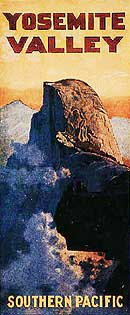On Early Yosemite Artists
Reprinted from the John
Muir Newsletter ,
Vol. 2, No.2, Spring 1992
YOSEMITE VALLEY - - Katherine M. Littell
of Harvard University has published a short essay about early Yosemite
artists entitled, "Chris Jorgensen and the Pioneer Artists of Yosemite."
It has appeared in the fall, 1990 issue
of the Harvard Graduate Society Newsletter . Littell reports that
nineteenth century artists were very much responsible for the political
viability of Yosemite.
The new Yosemite Grant needed tourism to
be financially stable. California had accepted administration of
Yosemite in 1866 but was not given any funds by the federal government
to handle its responsibility.
To pay for the costs of supervising Yosemite,
Littell concludes that "Increasingly, the Commissioners looked to
artists and photographers to popularize the unique loveliness of
the Grant... "
Accordingly, Frederick Lee Olmstead, Chair
of the Yosemite Commission, asked Virgil Williams (later Director
of California School of Design), artist Thomas Hill and photographer
C.E. Watkins, for advice on how to make Yosemite a stronger tourist
attraction.
Of interest here is the fact that even
those who had taken on the responsibility of protecting Yosemite
were, even at the outset, interested in altering it. "Are there
any conditions affecting the scenery of the Yosemite unfavorably,"
Olmstead asked the three artists, "which it would prove in
the power of the State to remove?" This is, of course, precisely
the notion of "improving the Valley" that John Muir argued against
in his first writings for the San Francisco Bulletin.
Muir argued often and publicly that any
effort to "improve" the Valley was silly, and pointedly made fun
of the little dam built by hotelier Snow to divert a side stream
of the Merced so it would flow over the main Nevada falls.
Littell's article is useful in providing
a context in which early Yosemite artists worked. Their paintings
were distributed nationwide.
Thousands saw them, and as cross-country travel became easier with
the completion of the Union Pacific in 1869, other thousands came
to visit California, including Yosemite.
Evidently, Muir himself was inspired to visit Yosemite when he saw
a painting of the Valley, while recovering from his eye accident.
Beginning with Ayres and Hill, James Alden, William Smith Jewett,
Albert Bierstadt, and finally Chris Jorgensen, the author finds
that each "was forced to differentiate their styles to capture its
compelling beauty."
Unlike the Hudson River School group that
preceded them, Littell writes, the Yosemite artists "either enthusiastically
or reluctantly, took on a political dimension" since each was responsible
in one way or another for popularizing Yosemite. Not all Californians
wanted more tourists in their state: Ambrose Bierce rejoiced with
"grim satisfaction" in the "destruction by fire of Bierstadt's celebrated
picture of Yosemite Valley," which had, he stated, "incited more
unpleasant people to visit California than all our conspiring hotelkeepers
could compel to return."
Perhaps the most compelling theme of Professor
Littell's article is the new window for research which she implicitly
opens: What was the full political and environmental impact of tourism
on Yosemite and other wildernesses?
It has often seemed that Muir was in one
respect a tragic figure. Promoting tourism, he several times wrote
it was one of the "great, good signs of the times"; yet, it was
and remains an element responsible for the very destruction of wilderness.
Muir spoke of this dilemma on several occasions,
always opting to defend wilderness visitation. When North Dome became
finally accessible to hikers, Muir dismissed notions that any harm
might come from the new visitors, writing that he had "always discouraged
as much as possible every project for laddering the South Dome,
believing it would be a fine thing to keep this garden untrodden.
Now the pines will be carved with the initials
of Smith and Jones, and the gardens strewn with tin cans and bottles,
but the winter gales will blow most of this rubbish away, and avalanches
may strip off the ladders." ( San Francisco Daily Evening Bulletin
, Nov., 18, 1875.)
His later articles from Alaska quite clearly
call for Americans to come visit their northern acquisition: "Go,
go and see," he directed. And, of course, the initial purpose of
the Sierra Club was to make the mountains more accessible.
Professor Littell's suggestive essay raises
the question as to whether Muir or the other artists may have come
to harbor self-doubts about the wisdom of the policy.
Yosemite Domes
Under Fire! [6/02/1887]
The "Yosemite Domes" is the name of Bierstadt's last picture.
The art critics here abused it without stint when its exhibition
began, a month ago. They ridiculed it so mercilessly that I thought
it surely could not be worth going to see, and so I stayed away.

|







